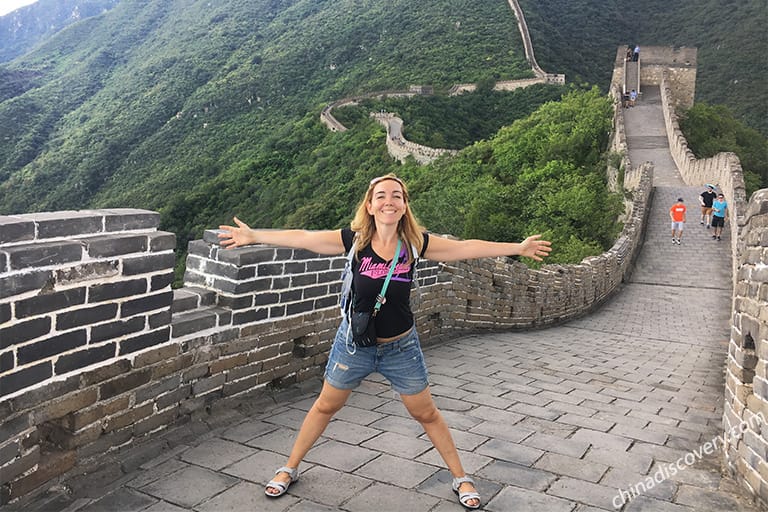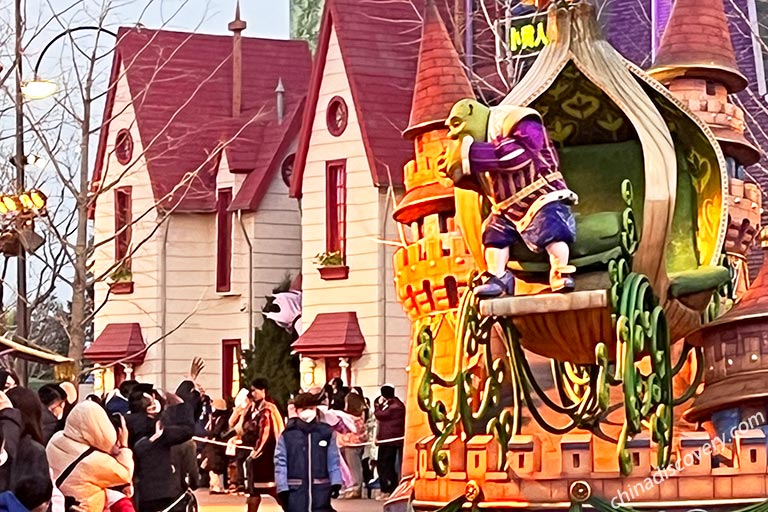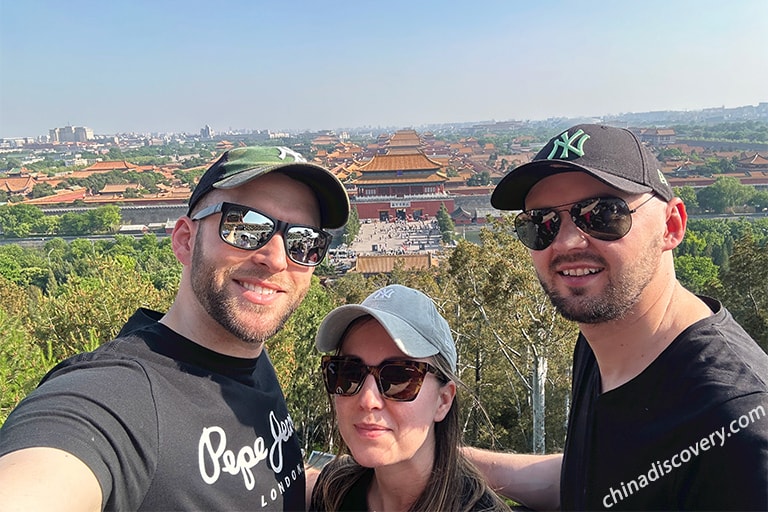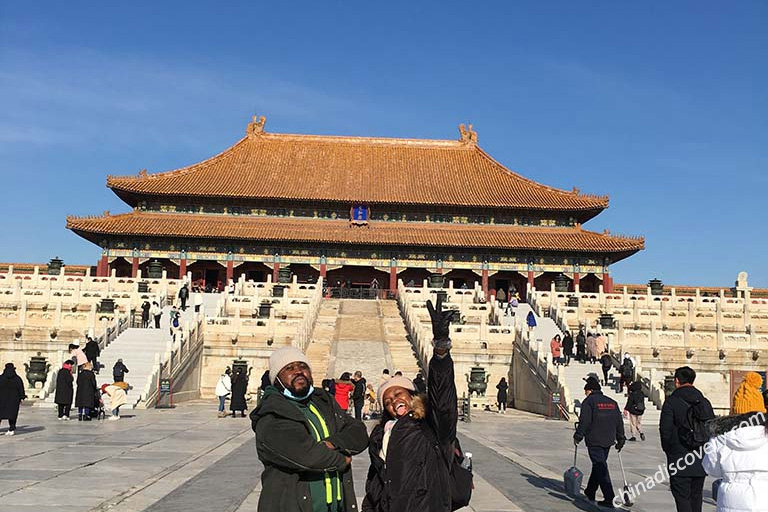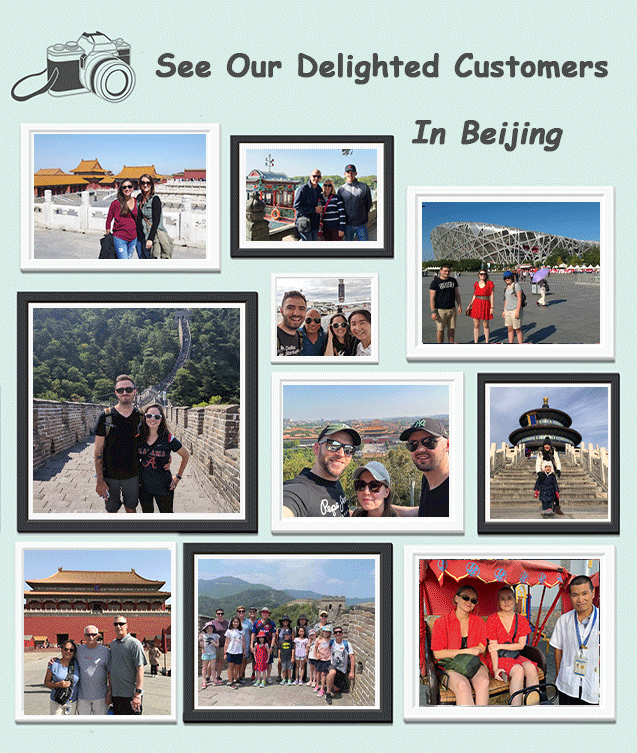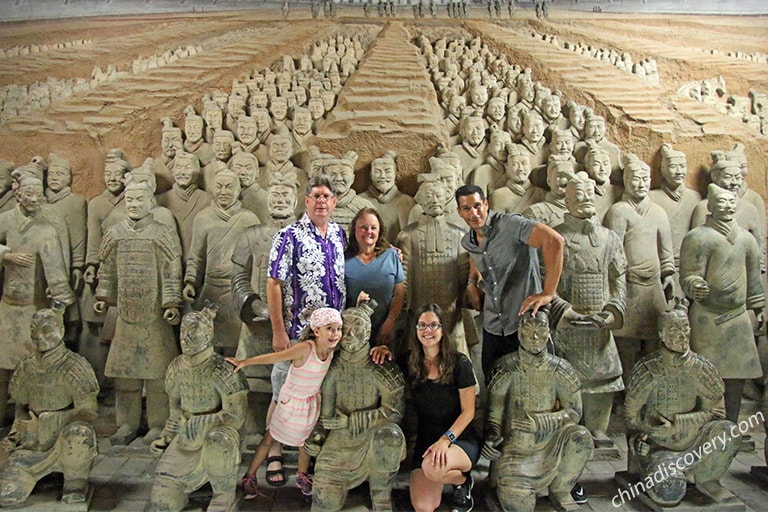Top 10 Most Recommended Beijing Hutongs to Visit
Beijing, as the capital city of six dynasties in andcient time, keeps an over three millennia-year succession of dynasties as well as stories of generations of Beijingers taking root and living their lives. The memories of Beijing are retained in long, short, wide, narrow, straight and winding alleys, namely hutongs in Chinese, among the traditional quandrangle dwellings Siheyuan (四合院). Over 6,000 hutongs interlaced with one another in the Beijing city carries the vitality and pulse of Beijing and you're highly recommended to have a look. Most Hutongs gather in the south and north of the Forbidden City in the downtown areas of Beijing, in Dongcheng and Xicheng District. Notably, Many hutongs, some several hundred years old, in the vicinity of Shichai (什刹海) and Bell Tower & Drum Tower are well preserved and the two area abound with tourists as well.
Shichahai Hutongs Area
Shichahai (什刹海), divided into Qianhai (前海), Houhai (后海) and Xihai (西海), best keeps the most old Beijing buildings, so you can visit about 15 hutongs with particular features, imperial mansions and former homes of renowned people in this area, like the Prince Gong’s Mansion (恭亲王府), which is the most-preserved palace of a prince of Qing dynasty in Beijing and a typical garden palace of a prince. What’s more, Shichahai is a famous tourism sightseeing area in Beijing. Fascinating natural scenery with lush plants and crystal clear lakes are placed here, which enables Shichahai to get the honor as the “Western Watery Place in China”.
Address: Xicheng District, Beijing.
 Shichahai
Shichahai
Bell Tower & Drum Tower Hutongs Area
The Bell Tower (钟楼) and the Drum Tower (鼓楼) are the must-visit places for people first visiting Beijing. Hutongs in this area extend in all directions with famous Beijing time-honored brands and antique culture surrounding. It is really like a magic experience to roam in these deep and quiet hutongs, admiring the old pines and overhanging eaves of the hundreds-year-old dwellings, and hearing the ear-pleasing chime and drumbeat at a fixed time.
Address: Zhonglouwan, Dongcheng District, Beijing.
 The Bell Tower
The Bell Tower
Beijing Hutong is not only a pass in this city, but also the vital stage showing the historical and cultural evolution of the ancient capital. Every hutong seems like a museum of folk custom with rich culture and features of era. Among the numerous Hutongs, there are 10 most popular ones and Nanluoguxiang and Yandaixie Street are the most visited by travelers.
Nanluoguxiang
Nanluoguxiang (南锣鼓巷), or called South Gong & Drum Alley, 8m wide and 787m long, is one of the oldest blocks in Beijing built more than 740 years ago. It is also the traditional residential area of checkerboard type with the most-preserved texture of hutong and courtyard in the Yuan dynasty (A.D. 1271 - 1368), largest scale, highest level and most resources in China and richest old Beijing flavor. Since it was a rich land hundreds of years ago, countless imperial mansions and grand courtyards are left along this alley.>> Read More about Nanluoguxiang
Address: Dongcheng District, Beijing.
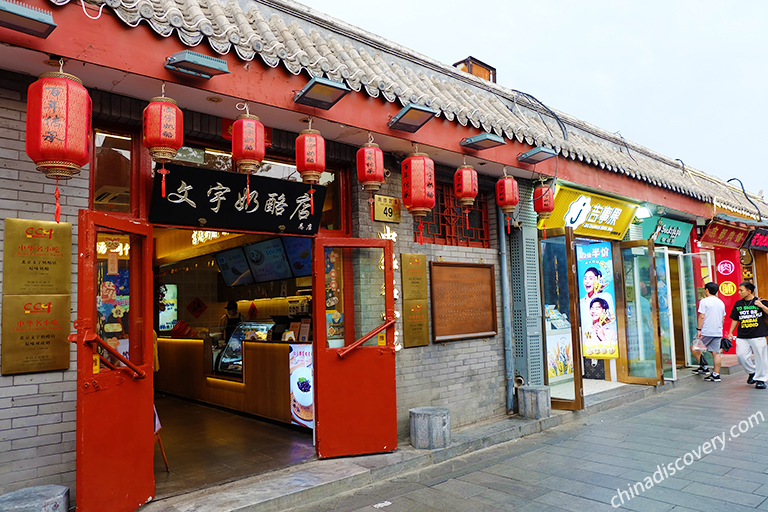 Nanluoguxiang Hutongs Beijing
Nanluoguxiang Hutongs Beijing
Yandaixie Street
Yandaixie Street, or Yandai Byway (烟袋斜街), is the oldest slanting street in Beijing with a length of 232m. It got the name because a lot of stores sell long-stemmed Chinese pipes and hookahs, and other smoking sets are prevailing along this street from the late Qing dynasty to 1930s. Furthermore, since Yandaixie Street is a top famous cultural street in northern Beijing with abundant simple old Bejing buildings and full atmosphere of cultural and artistic breath, tourists can see the remains of many cultural celebrities and find antiques, painting and calligraphic works, and ancient constructions, etc. in this great place.>> Read More about Yandaixie Street
Address: Xicheng District, Beijing; in front of the Drum Tower.
 Yandanxiejie Hutongs Beijing
Yandanxiejie Hutongs Beijing
Dongjiaomin Lane (东交民巷)
Dongjiaomin Lane with a length of 1.6 km is the longest hutong in Beijing. In Yuan Dynasty (1271 AD - 1368 AD), Dongjiaomin Lane and Xijiaomin Lane (西交民巷) are an alley connected together. There is a waterway then connecting the North-South Grand Canal. The grain ships were moored in this ally and merchants sold out the grain on the spot. Hence people simply called the alley Jiangmi Lane (江米巷), the same meaning as rice by the river. Later since 1860 Dongjiaomin Lane has become a concentration lot of foreign embassies in China. Lots of European-styled architectures rose from the ground.
Address: Dongcheng District, Beijing.
Mao'er Hutong (帽儿胡同)
In the Ming Dynasty, it was called Zitong Temple Wenchang Palace (梓潼庙文昌宫) which was dedicated to worship Emperor Wenchang, who in ancient myths and legends was the star of wisdom and the god in charge of a nation's civilization. Besides, No. 9 and No. 11 of Mao'er Hutong are Ke Garden (可园), which are one of the most representative private gardens in Beijing, while Nos. 35 and 37 are the former residences of the last Empress Wanrong of Qing Dynasty (末代皇后婉容). Tourists can enjoy a deep cultural atmosphere as well as admire exquisitely designed dwellings.
Address: Xicheng District, Beijing; in front of the Drum Tower.
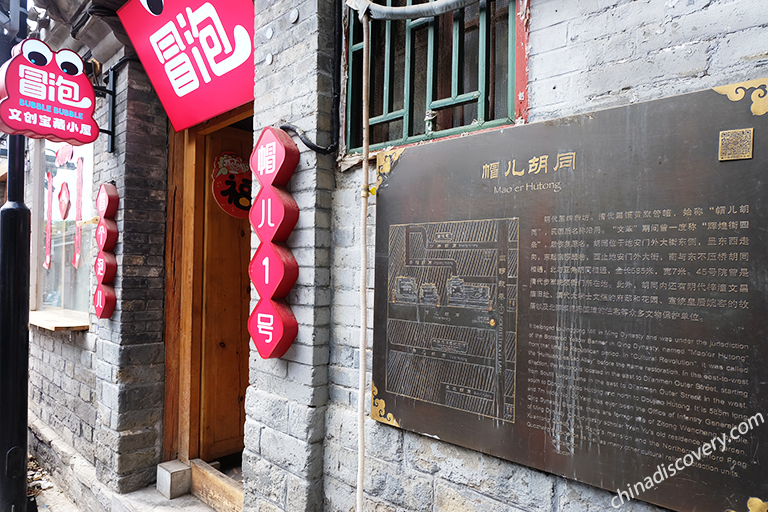 Mao'er Hutong in Beijing
Mao'er Hutong in Beijing
Apart from the hutongs mentioned above, Guozijian Street (国子监街) which conserves most of architectures and Siheyuan (四合院) of Ming and Qing dynasties, Liulichang Cultural Street (琉璃厂文化街) selling various craftwork, artistry, and antiques, Ju’er Hutong (菊儿胡同), Bada Hutong (八大胡同) and Jinyu Hutong (金鱼胡同) with a deep cultural atmosphere, and the old "Financial Street of Old Beijing" Xijiaomin Lane (西交民巷) are also a good resort.
Get Close to Beijing Hutongs – Things to Do
You can choose many different ways to get close to these characteristic Beijing Hutongs to appreciate the special ancient buildings and to experience the local old life and rich Beijing culture, such as enjoying the special buildings on a rickshaw; learning to make dumplings in a local residence; biking through the deep hutongs, etc.
Take a Rickshaw to Visit Hutongs
Almost all friends from other countries prefer to take a rickshaw to visit the old hutongs. They can both appreciate the ancient alleys with grey brick walls and particular northern Chinese quadrangle courtyards, and listen to the related history and stories along the way since some wheelers can speak some English. Moreover, you can see the remained palace of the prince to admire the excellence in the gardens and decorations and to experience the past life and prosperity of Chinese imperial household. ⨠ Check Beijing Hutong Rickshaws to know rickshaw routes, rickshaw fare, ect.
 Our Guests from USA Taking a Rickshaw at Beijing Hutongs
Our Guests from USA Taking a Rickshaw at Beijing Hutongs
Make Dumplings in a Local Family
You can choose to take the chance of making dumplings in a local residence in a hutong, which is an uncommon opportunity to know every step of making these delicious northern China dumplings and understand more about the rich culture of family reunion and the sincere hope for bright future life in China. Also, you can feel it really interesting, warm and sweet to enjoy a meal with the hospitable Beijing people.
Bike along Beijing Hutongs
Renting a bike to roam along the hutongs is of full fun as well. You can enjoy the historical feature in the deep and serene hutongs, watch the local Beijing people’s daily life, and appreciate and charming sightseeing near these old buildings. You will understand why foreign people say that Beijing Hutongs are so beautiful and charming!
Besides those featured activities, you can also choose other interesting things to do to enjoy the real life and local culture of old Beijing, such as learning the Chinese paper cutting of various patterns, trying the calligraphy to know the ancient writing of Chinese, making Chinese Knots, Yangko dancing, etc.
 Our Guests Visiting Local Family at Beijing Hutongs
Our Guests Visiting Local Family at Beijing Hutongs
Recommended Route to Visit Beijing Hutongs
Since the number of Beijing Hutongs is so large, we recommended you to visit some representative featured ones to experience its rich culture.
Usual Tourist Route
Visit the Bell & Drum Towers Hutongs to hear the chime and drumbeat and enjoy the old different hutongs along the way, and see the old former houses of celebrities, like the Prince Gong’s Mansion. Then wander along other interesting hutongs to Shichahai area and appreciate the beautiful landscape. (For about 2-4 hours)
Special Photographic Route
Visit the South Gong & Drum Alley to capture images of the best-preserved residential area of checkerboard type. See the fascinating natural scenery in Shichahai and take pictures of the well preserved former houses of famous people. Then, go to the Pipe Slanting Street to enjoy the rich culture and artistic breath of simplicity. Next, go to feel the antique flavor of the old boutiques and hear the crispy sound of the ancient bell and drum in Bell & Drum Tower Hutongs. (For a half to one day)
Recommende Beijing Tours with Beijing Hutongs:Warm Tips to Visit Beijing Hutongs
1. There are some places for renting bicycles near Shichahai and other sites, and if you want to bike along the old Hutong, renting one there is very convenient and great to savor the culture and constructions in the old alleys.
2. Some narrow Beijing hutongs may not have lights at night, so it is not recommended to visit these dark hutongs during night.
Learn Beijing Hutongs Culture
Want to make an exploration of Beijing Hutongs? Then you shouldn't fail to have an understanding of the culture behind hutongs, the architectures themselves.
Origin of Beijing Hutongs
Hutong (胡同) is also called “lane” (里弄) and “alley” (巷), meaning the narrow streets leading to the inside of the residential area between the main streets in the town or the country. Hutong originated from Yuan dynasty (1271 -1368 AD), when the Mongolian in Dadu (大都, the national capital at that time) called most streets hutong (meaning the well in Mongolian language). And it's said that the Mongolian people dug many wells for more water resource at that time, so it got the name of Hutong.
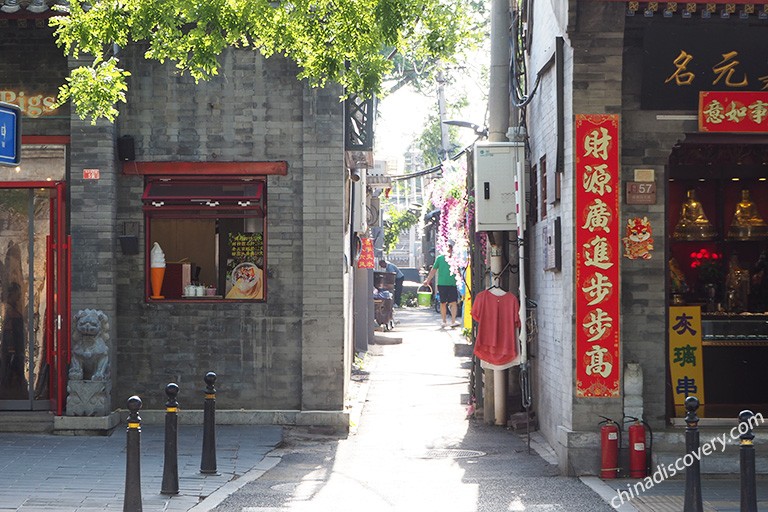 Authentic Beijing Hutongs
Authentic Beijing Hutongs
Features of Beijing Hutongs
Most Beijing Hutongs are oriented south and north as well as east and west . Those south & north oriented ones are wide relatively and also called street for they mainly serviced the carriages before; the east & north directed are narrower for people walking. These hutongs are all near the noisy places, however, the sounds of people and vehicles are totally cut off away, leaving only serenity and peace here inside.
Moreover, different from other cities where people are inclined to name a place after a city name, like Nanjing Road, Guangzhou Road, place names in Beijing are more of living. All hutongs have their characteristic folksy names, from rivers, lakes, mountains, moons, surnames, temples, commodities, factories, flowers, fishes, clouds, stars, water, wells, harbors, wind, fire, trees, chickens, meat, etc. like Yuer Hutong (雨儿胡同, Rain Hutong), Haibin Hutong (海滨胡同, Harbor Hutong), Jinger Hutong (井儿胡同, Hutong of Well), and so on.
Although all hutongs look the same, every one has its unique characteristic. People who go to the modern Beijing wound first long for going to see the more than 6,000 deep and serene narrow hutongs and fair quadrangle dwellings rather than those super-high rises or the wide broadways. It is no wonder that Beijing ancient capital culture is regarded as “culture of Hutongs” or “culture of quadrangle dwellings”.
 Beijing Hutong Photo by Our Guest
Beijing Hutong Photo by Our Guest
 A Corner of Beijng Hutongs
A Corner of Beijng Hutongs
How to Plan Your Travel in Beijing
To explore Beijing's highlights, such as the Forbidden City, the Great Wall (with Mutianyu as the top recommendation), the Temple of Heaven, the Summer Palace, and the Beijing Hutongs - plan for about 4 days, including arrival and departure.
☛ 4 Days Classic Beijing Tour Package
☛ 3 Days Beijing Essential Highlights Tour
If you have extra days, consider hiking the scenic Jinshanling Great Wall, enjoying the stunning night views of Simatai Great Wall, or visiting other sections like Huanghuacheng, Gubeikou, and Juyongguan.
☛ 4 Days Beijing Essence Tour with Simatai Great Wall Night Sightseeing
☛ 4 Days Classic Beijing Tour with Jinshanling Great Wall Hiking
Families with children should not miss Universal Beijing Resort, while museum enthusiasts should visit the National Museum of China, home to the nation's most valuable treasures.
☛ 5 Days Beijing Family-friendly Tour with Universal Studios Fun
☛ 5 Days In-depth Beijing Tour with History and Culture Discovery
As a major transportation hub, Beijing offers easy access to other top destinations in China by flight or train, such as Xi'an, Shanghai, Guilin, Chengdu, and Tibet. China Discovery provides a variety of tour packages from Beijing, or we can customize an itinerary to suit your preferences.
Recommended Beijing Tours with Other Top Cities in China:
☛ 6 Days Classic Beijing Xian High-speed Train Tour
☛ 8 Days Best of China Tour (Beijing - Xian - Shanghai)
☛ 10 Days Classic China Tour from Beijing (Beijing - Xian - Guilin - Shanghai)
We have helped many global travelers enjoy their memorable wonderful trips to Beijing for the past few years. Among them, a special team of over 50 VIPKID teachers from North America traveled with us to see their dear studends in China with amazing experience in Beijing and shared us their special travel story! Travel with China Discovery to create your great China trip memories!
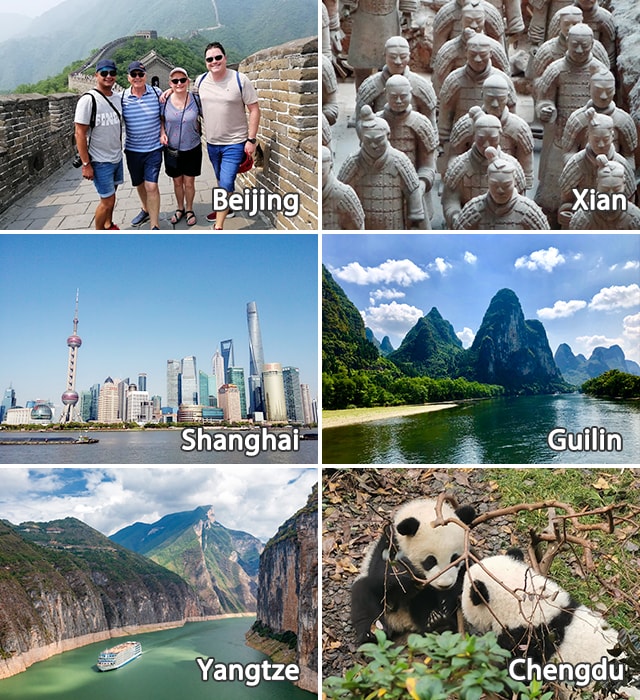 Top China Recommended Destinations
Top China Recommended Destinations
Recommended Beijing Tours
Top 3 Beijing tours chosen by most customers to explore Beijing in the best way. Check the detailed itinerary, or tailor your own trip now with us.

8 Days Best of China Tour (Flight/Bullet Train Covered)
Beijing / Xian / Shanghai

4 Days Beijing Essence Tour with Simatai Great Wall Night Sightseeing
Beijing / Jinshanling / Simatai / Gubeikou Water Town / Beijing
Start planning your tailor-made holiday to China by contacting one of our specialists. Once inquired, you’ll get a response within 0.5~23.5 hours.
Customize a TripHave a question? Get answers from our travel experts or guests
- Your Question:
- Your Name:
- Your Email:
- Submit



























